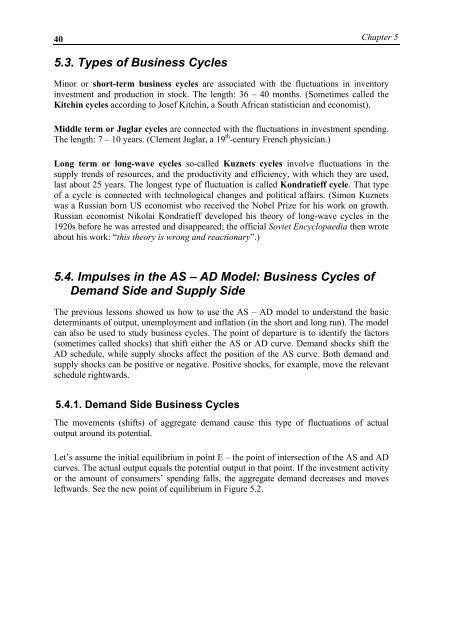MacroeconomicsI_working_version (1)
Create successful ePaper yourself
Turn your PDF publications into a flip-book with our unique Google optimized e-Paper software.
40<br />
Chapter 5<br />
5.3. Types of Business Cycles<br />
Minor or short-term business cycles are associated with the fluctuations in inventory<br />
investment and production in stock. The length: 36 – 40 months. (Sometimes called the<br />
Kitchin cycles according to Josef Kitchin, a South African statistician and economist).<br />
Middle term or Juglar cycles are connected with the fluctuations in investment spending.<br />
The length: 7 – 10 years. (Clement Juglar, a 19 th -century French physician.)<br />
Long term or long-wave cycles so-called Kuznets cycles involve fluctuations in the<br />
supply trends of resources, and the productivity and efficiency, with which they are used,<br />
last about 25 years. The longest type of fluctuation is called Kondratieff cycle. That type<br />
of a cycle is connected with technological changes and political affairs. (Simon Kuznets<br />
was a Russian born US economist who received the Nobel Prize for his work on growth.<br />
Russian economist Nikolai Kondratieff developed his theory of long-wave cycles in the<br />
1920s before he was arrested and disappeared; the official Soviet Encyclopaedia then wrote<br />
about his work: “this theory is wrong and reactionary”.)<br />
5.4. Impulses in the AS – AD Model: Business Cycles of<br />
Demand Side and Supply Side<br />
The previous lessons showed us how to use the AS – AD model to understand the basic<br />
determinants of output, unemployment and inflation (in the short and long run). The model<br />
can also be used to study business cycles. The point of departure is to identify the factors<br />
(sometimes called shocks) that shift either the AS or AD curve. Demand shocks shift the<br />
AD schedule, while supply shocks affect the position of the AS curve. Both demand and<br />
supply shocks can be positive or negative. Positive shocks, for example, move the relevant<br />
schedule rightwards.<br />
5.4.1. Demand Side Business Cycles<br />
The movements (shifts) of aggregate demand cause this type of fluctuations of actual<br />
output around its potential.<br />
Let’s assume the initial equilibrium in point E – the point of intersection of the AS and AD<br />
curves. The actual output equals the potential output in that point. If the investment activity<br />
or the amount of consumers’ spending falls, the aggregate demand decreases and moves<br />
leftwards. See the new point of equilibrium in Figure 5.2.




